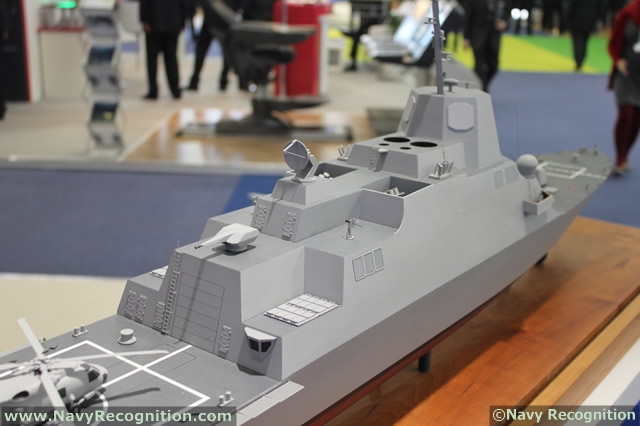| |
|||
| a | |||
Naval
Forces News - USA |
|||
US
Defense budget preview: LCS number limited to 32, US Navy to study alternatives
& modifications |
|||
US
Defense Secretary Chuck Hagel’s budget preview held yesterday
set the stage for the administration’s fiscal 2015 budget rollout
and announced that the number of Littoral
Combat Ships would be limited to 32 units. The Defense Secretary
asked the US Navy to start studying possible alternatives including
a completely new design, existing ship designs, and a modified LCS. |
|||
 Lockheed Martin's Multi-Mission Combatant as shown during Euronaval 2012. Pitched as the export variant of the LCS, it is essentially an LCS design fitted with extra sensors and weapons which turns it into a potent Frigate-like multirole surface combatant. (On this scale model it is fitted with AEGIS, Thales Sonar, MK41 VLS, Oto Melara 76mm, Harpoon anti-ship missiles and Millenium 35mm guns) |
|||
Excerpt
from FY15 Budget Preview as Delivered by Secretary of Defense Chuck
Hagel, Pentagon Press Briefing Room, Monday, February 24, 2014: Overall, the Navy’s fleet will be significantly modernized under our plan, which continues buying two destroyers and two attack submarines per year, as well as one additional Afloat Staging Base. We have preserved the fleet’s modernization programs and provided for increases in ship inventory over the next five years. Regarding the Navy’s Littoral Combat Ship, I am concerned that the Navy is relying too heavily on the LCS to achieve its long-term goals for ship numbers. Therefore, no new contract negotiations beyond 32 ships will go forward. With this decision, the LCS line will continue beyond our five-year budget plan with no interruptions. The LCS was designed to perform certain missions – such as mine sweeping and anti-submarine warfare – in a relatively permissive environment. But we need to closely examine whether the LCS has the protection and firepower to survive against a more advanced military adversary and emerging new technologies, especially in the Asia Pacific. If we were to build out the LCS program to 52 ships, as previously planned, it would represent one-sixth of our future 300-ship Navy. Given continued fiscal constraints, we must direct shipbuilding resources toward platforms that can operate in every region and along the full spectrum of conflict. Additionally, at my direction, the Navy will submit alternative proposals to procure a capable and lethal small surface combatant, consistent with the capabilities of a frigate. I’ve directed the Navy to consider a completely new design, existing ship designs, and a modified LCS. These proposals are due to me later this year in time to inform next year’s budget submission. If sequestration spending levels return in 2016 and beyond, we will be forced into much tougher decisions on the Navy surface fleet. Six additional ships would have to be laid up, and we would have to slow the rate at which we buy destroyers. The net result of sequestration-level cuts would be ten fewer large surface combatant ships in the Navy’s operational inventory by 2023. Under sequestration spending levels, the Navy would also halt procurement of the carrier variant of the Joint Strike Fighter for two years. Link to the full speech |
US Defense budget preview: LCS number limited to 32, US Navy to study alternatives & modifications
- Posted On










